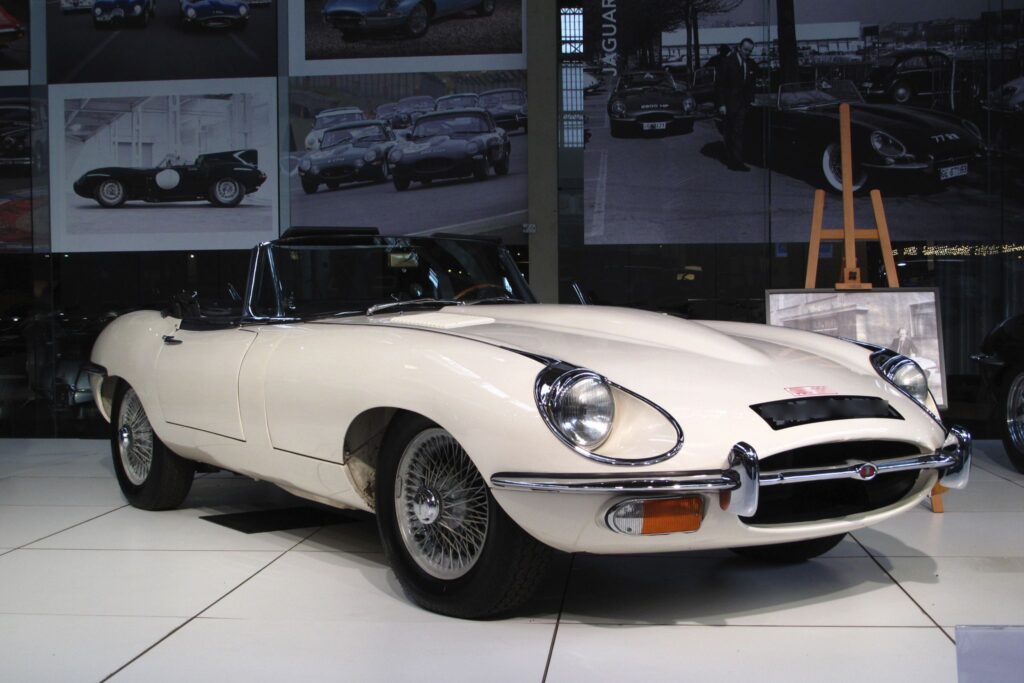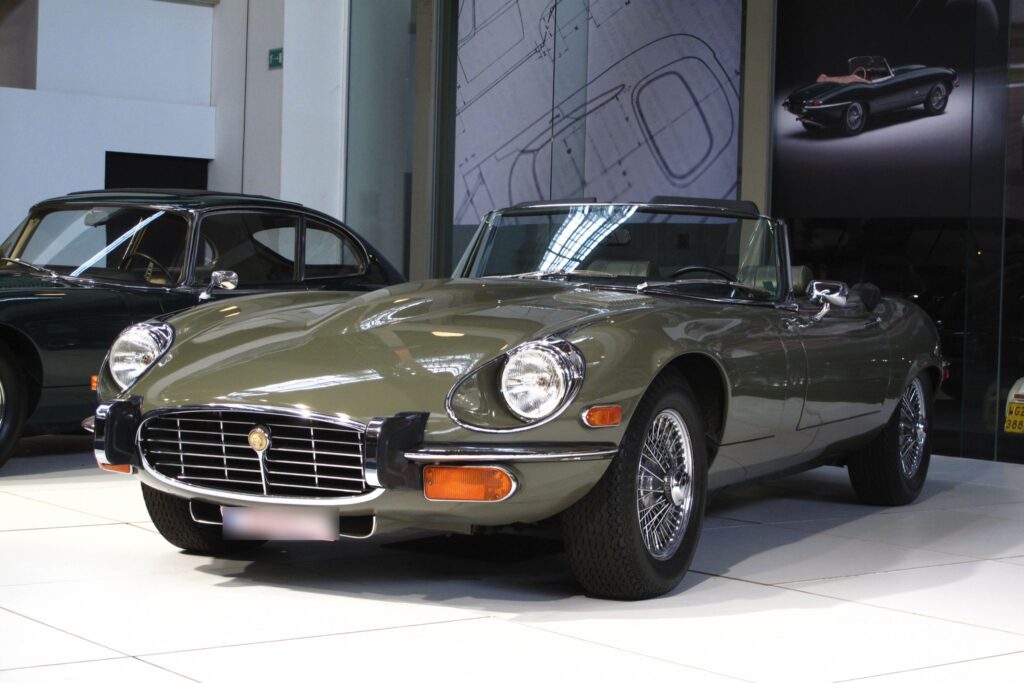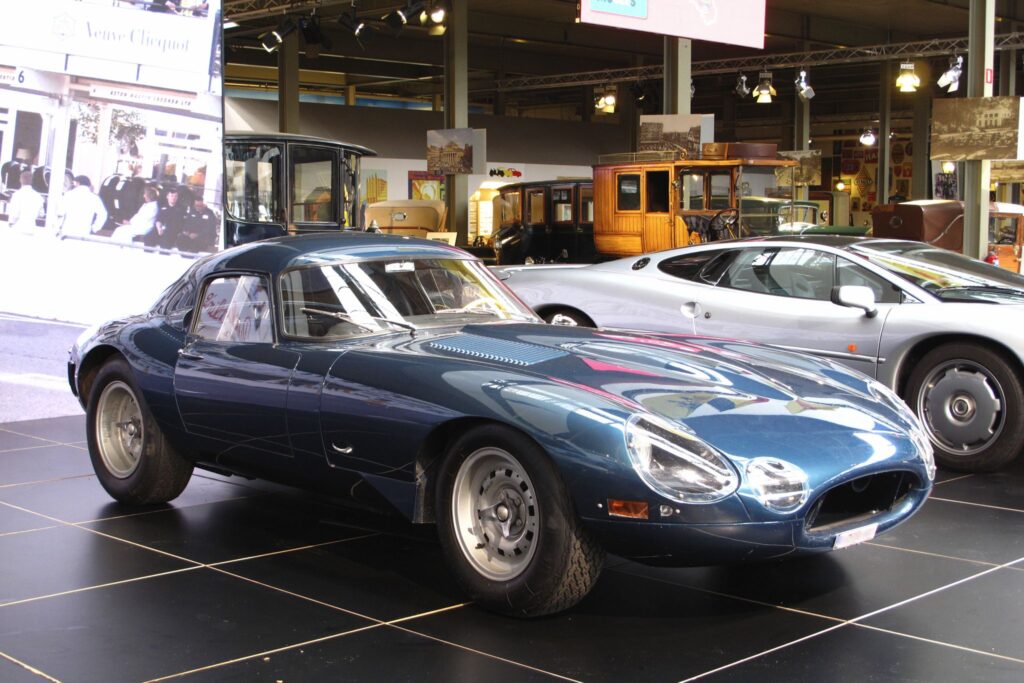When the Jaguar E-Type debuted at the Geneva Auto Salon on the 15th of March, 1961, former Ferrari boss Enzo Ferrari famously called it “the most beautiful car in the world.” And beautiful it was; this was confirmed when it topped The Daily Telegraph’s list of the world’s “100 most beautiful cars of all time” in 2008. The E-Type was not just about good looks. This engineering work of genius was also one of the fastest road-going sports cars of its day, boasting a top speed of 150 mph (241 km/h) and a zero-to-60 mph sprinting time of less than 7 seconds. Even better was the fact that Jaguar was offering the E-Type with a starting price of just £2,196 for the Coupe and £ 2,097 for the Roadster. To put this in context, the E-Type was faster than the Ferrari or Aston Martin sports cars of that time and was also much cheaper. It is not hard to see why the E-Type became an overnight sensation when it debuted. Jaguar got its first 500 orders for the car while still in Geneva.
Where E-Type Story began
Inspired by the Jaguar XK sports car’s success Sir William Lyons, fondly referred to by Jaguar enthusiasts as “Mr. Jaguar,” looked to get a worthy successor for it in the 1950s. He wanted it to be a car that would captivate sports car lovers even more with its design aesthetics and still offer powerful performance and maintain the class and refinement for which the Jaguar brand had become known. By then, Jaguar was dominating the motorsports scene with its C-Type and D-Type race cars, which had achieved multiple wins at the Le Mans 24 Hours race in France. Malcolm Sayer helped to design both of them, and he was also commissioned to design the E-Type; hence the reason why the E-Type’s design borrows considerably from its predecessors.
The 1957 E1A Prototype
First came the E1A race car prototype in 1957, which had an aluminum monocoque design, a fully independent rear suspension, and a 2.4-litre engine from the Jaguar XK. It was devoid of headlights and was considerably smaller than the eventual, road-going E-Type car. Jaguar primarily used it for factory testing.
The 1960 E2A Prototype
The lessons learned from the E1A helped to develop the E2A prototype. It was built to be a fully capable race car with a steel chassis, a 3.0- litre twin-cam straight-six XK engine with Lucas fuel injection, and a headrest for the driver. American Briggs Cunningham made a deal with Jaguar to race the E2A at the 1960 Le Mans race. The E2A didn’t finish the race, but the preparation for the race and the race itself helped resolve several issues, including the unreliability of its 3.0-litre engine and the toe-out of its rear wheels. Jaguar addressed these problems as it developed the finished, production-ready E-Type car.
E-Type Series 1 (1961-1968)
Jaguar’s Public Relations Manager Bob Berry was given the honor of driving the Jaguar E-Type Series 1 demonstration car (registration number 9600 HP) to the 1961 Geneva Auto Salon at the Parc des Eaux Vives in Geneva. He famously drove overnight from Coventry. Sir William Lyons also called up Jaguar test driver Norman Dewis to drive yet another E-Type demonstration car (registration number 77RW) to Geneva because of the overwhelming demand for the car.

The E-Type Series 1’s design language was similar to the D-Type – an aerodynamic silhouette with a long, pointed front end, delicate lines and curves, bulging front fenders, and a short, stubby rear end. It mirrored Malcolm Sayer’s aeronautic design roots. Driving the Series 1 models was a well-tuned, carburetted 3.8-litre six-cylinder engine that made 265bhp and 240 lb.-ft. of torque. In late 1964, this engine’s displacement was increased to 4.2 litres; this increased the engine’s torque to 283 pound-feet. It was paired with a 4-speed manual transmission; a 3-speed automatic was available from 1966.
The E-Type Series 1 models were made between 1961 and 1966 and are only available in two forms: a two-seater ‘fixed head coupe’ (FHC) form or a two-seater convertible or ‘open two seater’ (OTS). Those made after 1966 are also available in a lengthened 2+2″ four-seater coupé body style. Jaguar sold a total of 38,419 Series 1 units.
Other noteworthy features in the Series 1 models include disc brakes and a rack-and-pinion steering system.

Series 2 (1968-1971)
The E-Type Series 2 lacks glass headlight covers and has a wrap-around rear bumper and a slightly larger grille. Jaguar produced a total of 18,808 E-Type Series 2 cars. Like the Series 1 models, the Series 2s were available in Open Two Seater, Fixed Head Coupe, or 2+2″ four-seater body styles.
The US-bound Series 2 models got a few updates, including a steering-column mounted ignition switch, a collapsible steering wheel column, and redesigned seats with head restraints. These export models also got a detuned engine that made 246 hp and 263 lb.-ft. of torque.
Series 3 (1971–74)

The E-Type Series 3 got even more updates, the most significant of which was a roaring 272 hp 5.3 L V12 engine paired solely with an automatic transmission. Jaguar dropped the short wheelbase and Fixed Head Coupe body styles for the Series 3; it only kept the long-wheelbase convertible and 2+2″ four-seater coupé Series 3 versions for these models. The additional innovations and features that the Series 3 models got include air conditioning, power steering, a cross-slatted front grille, and four exhaust tips.
In addition, Jaguar also made fifty special-edition Series 3 models to commemorate the end of the E-Type. These models had chromium-plated wheels, cinnamon interior upholstery, and exclusive dashboard identification plaques. Forty-nine were painted black, while the last one was adorned in dark green to comply with its owner’s request.
In total, Jaguar made 15,287 Series 3 units.
Motorsports Exploits
The Jaguar E-Type was never meant to be a race car. However, because it shared the underpinnings of the Le Mans-driven D-Type race car, Jaguar couldn’t resist the temptation to see how it would do in motorsports. Just a month after its launch, the E-Type won its first race at Oulton Park Circuit, Cheshire, England, where young race-car driver Graham Hill fended off Ferrari 250 GT and Aston Martin DB4 racers to win convincingly.
The Low Drag Coupé and E-type Lightweight


Inspired by the E-Type’s apparent motorsports potential, Jaguar set about investigating whether this car could take after the D-Type race car, and came up with the E-Type Low Drag Coupé in 1962. It had a lighter aluminum body, a stripped-down cockpit, Perspex-glass windows and windshield, and a low drag roof. Jaguar made only one model.
In 1963, Jaguar tried again, building on its progress with the Low Drag Coupé. The outcome was a hardcore racing variant dubbed the ‘Lightweight E-Type’ because it was considerably lighter than the base model; it weighed less than 1,000 kg. It was designed as an open-top car in the spirit of the D-Type and was fitted with a retuned 300-hp 3.8-litre straight-six engine that pairs with an exclusive close-ratio four-speed gearbox or a ZF five-speed gearbox. The Lightweight E-Type has more extensive aluminum-alloy construction, hence the low curb weight.
Jaguar only planned to build 18 Lightweight E-Type models, but only 12 models were developed during the 1960s. In 2014, Jaguar finally decided to complete the Lightweight E-Type project. It set up a Special Vehicle Operations (SVO) unit charged with building the remaining six Lightweight E-Type models. The unit first delivered a prototype in 2015 before finally releasing the completed models.
Jaguar fielded the Lightweight E-Type in numerous UK production car racing competitions and local and international endurance-racing competitions like the Le Mans 24 Hours, 12 Hours of Sebring, and the Nürburgring. It was notably successful in all the competitions in which it participated.
Mainly Produced For Export
Jaguar started exporting the E-Type to North America just a month after its launch in Geneva. Amazingly, two-thirds of all Jaguar E-Types produced were exported to the USA. In North America, the E-Type is known as the Jaguar XK-E.
Sales Success or Flop?
Without a doubt, the Jaguar E-Type was critical to establishing the Jaguar brand, probably more than the 911 was to Porsche. However, it never became the resounding sales success that Jaguar desired it to be. Jaguar only produced an average of 82 units of the Series 1 model per week during its first years of production. That number increased to an average of 92 cars a week when making the Series 2 and Series 3 models. These figures say a lot about the underwhelming demand for the car, but Jaguar’s painfully lengthy production process may have had a hand in this. Jaguar had not done much to automate and improve its factory’s production processes since it started operations in the 1930s, so a great deal of the parts assembly work was done by hand.
The End of the E-Type Era
Demand for the Jaguar E-Type gradually decreased further in the early 1970s. Because of that, the company only made 3,705 E-Types in 1972. After that, the US government introduced a new set of car safety regulations that included incorporating roll bars in the coupe models. Jaguar saw the writing on the wall and opted to terminate the production of the E-Type coupes. It also ended the production of the E-Type roadsters in February 1975 when it came to light that Jaguar dealerships had too many unsold E-Type models.
Final Words
The E-Type helped to set the pace for car manufacturers in automotive design. It showed that it was possible to blend beautiful aesthetics with practicality and performance. Its innovative independent rear suspension design that considerably reduced unsprung mass to the wheels also changed the game in sports and race cars. The list of what the automotive world learned from the E-Type goes on and on. It will forever be considered among the greatest cars in automotive history.





